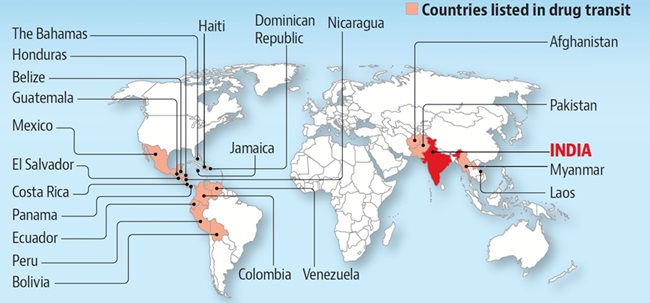Reference
There has been an alarming rise in drug use globally, according to a report released by the United Nations Office on Drugs and Crime (UNODC).
Key findings of the report
- The number of drug users worldwide was 292 million in 2022, a 20 percent increase over the previous decade.
- According to the report, cannabis is the most widely used drug worldwide, with 228 million users.
- These are followed by opioids (60 million users), amphetamines (30 million users), cocaine (23 million users) and ecstasy (20 million users).
- An estimated 64 million people worldwide suffer from substance use disorders. Despite this, only one in 11 people with drug use disorders receive treatment.
- Women, in particular, face enormous barriers, with only one in 18 women with drug use disorders receiving treatment.
- Global opium production has fallen drastically. Opium production is projected to fall by 74 percent in 2023.
- Opium production in Afghanistan has declined the most by 95 percent in 2023, while in Myanmar its production has increased by 36 percent.
major centers of illicit drug trade
- India is situated between the world's largest illicit opium production region, the Golden Crescent, and the world's largest opium consumption region, the Golden Triangle.
- Golden Crescent: This region of South Asia is a major global site for opium production and distribution. It includes Afghanistan, Iran, and Pakistan.
- The Indian states affected by this region are Jammu and Kashmir, Punjab, Rajasthan, and Gujarat.
- Golden Triangle: This region is located on the north-eastern border of India and meets at the confluence of Mekong and Ruak on the border of Laos, Myanmar and Thailand.
- Myanmar produces 80% of the world's heroin. After production, heroin is smuggled to the US, UK and China via Laos, Vietnam, Thailand and India.

Growing concerns about drug addiction in India
- Illicit supplies passing through India compromise its internal security and also pose a threat to its citizens.
- Weak security measures, rough terrain and dense forests along the India-Myanmar border provide easy access for smugglers.
- Local tribes and other residents get involved in criminal activities out of sympathy as there is considerable poverty, unemployment and illiteracy in the North Eastern regions.
- India is becoming both a big market and a transit route for other countries. About 90 percent of the world's drug demand is being met from the Golden Crescent and Golden Triangle regions.
- A new incident of use of drones to supply drugs and weapons across the border has come to light in Punjab.
- India has surprisingly become a hot destination for cocaine, which is controlled by South American drug cartels.
- These cartels have been found to have links with NRIs based in Canada, Australia, Singapore, Hong Kong and several European countries as well as local drug dealers and gangsters in India.
What needs to be done
- Evidence-based prevention programs should provide people, especially youth, with the knowledge and skills needed to avoid drug use.
- Drug trafficking empowers organised crime groups, which also expand into other illicit economies, such as wildlife trafficking, financial fraud and illegal resource extraction, so these activities must be controlled.
- A comprehensive strategy is needed to tackle drug use and its consequences. According to the UNODC, this requires prevention, treatment and the strengthening of law enforcement to disrupt the criminal networks that profit from these illicit activities.
